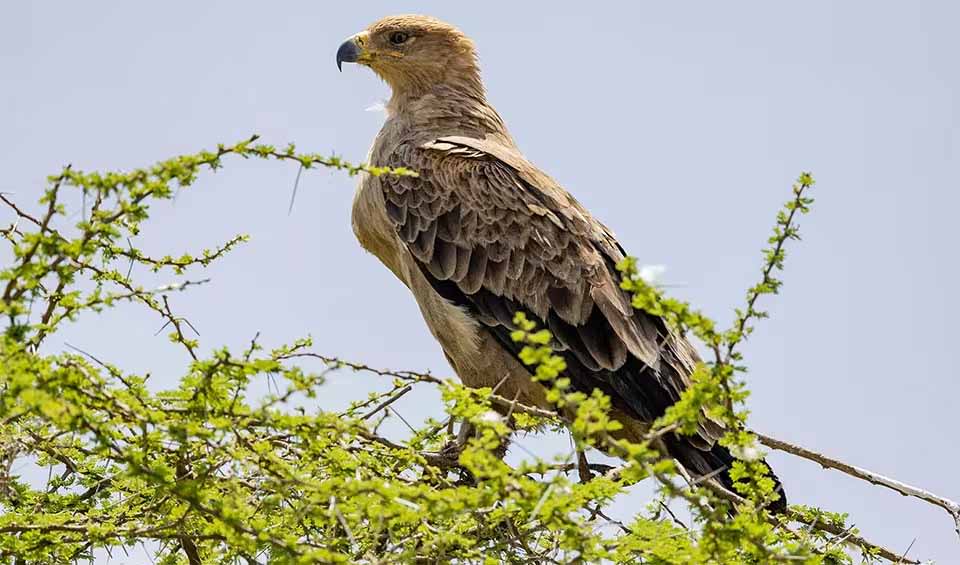A majestic bird of prey found across Africa and parts of South Asia. This large raptor is known for its impressive wingspan, which can reach up to 2 meters (6 feet), and its distinctive tawny-brown plumage, which gives it its name. Adult tawny eagles have a robust build, with broad wings and a slightly rounded tail. Their feathers range in color from light brown to dark brown, with a paler head and neck. This coloration provides excellent camouflage in their natural habitats, which include savannas, grasslands, deserts, and open woodlands.
Tawny eagles are skilled hunters with a diverse diet. They primarily feed on small mammals, birds, reptiles, and carrion. Their keen eyesight allows them to spot prey from great distances while soaring high in the sky. Once they identify a potential meal, they dive swiftly, capturing their prey with powerful talons. Tawny eagles are also known to scavenge, often feeding on carcasses left by other predators or roadkill. This opportunistic feeding behavior makes them important members of their ecosystems, helping to keep populations of smaller animals in check and cleaning up carrion.
These eagles are highly territorial and often seen alone or in pairs. They are known for their impressive aerial displays, which are particularly common during the breeding season. These displays include soaring, circling, and steep dives, often accompanied by loud, high-pitched calls. The tawny eagle’s vocalizations play a key role in communication between mates and in establishing and defending territories.
Distribution
 Algeria
Algeria Angola
Angola Bangladesh
Bangladesh Benin
Benin Botswana
Botswana Burkina Faso
Burkina Faso Burundi
Burundi Cameroon
Cameroon Central Af. Rep.
Central Af. Rep. Chad
Chad Congo-Brazzaville
Congo-Brazzaville Côte D’ivoire
Côte D’ivoire DR Congo (Kinshasa)
DR Congo (Kinshasa) Djibouti
Djibouti Egypt
Egypt Eritrea
Eritrea Eswatini
Eswatini Ethiopia
Ethiopia Gabon
Gabon Gambia
Gambia Ghana
Ghana Gibraltar
Gibraltar Guinea-Bissau
Guinea-Bissau Guinea
Guinea India
India Iran
Iran Israel
Israel Italy
Italy Kenya
Kenya Lesotho
Lesotho Liberia
Liberia Malawi
Malawi Mali
Mali Mauritania
Mauritania Morocco
Morocco Mozambique
Mozambique Myanmar
Myanmar Namibia
Namibia Nepal
Nepal Niger
Niger Nigeria
Nigeria Oman
Oman Pakistan
Pakistan Rwanda
Rwanda Saudi Arabia
Saudi Arabia Senegal
Senegal Sierra Leone
Sierra Leone Somalia
Somalia South Africa
South Africa South Sudan
South Sudan Sudan
Sudan Tanzania
Tanzania Thailand
Thailand Togo
Togo Tunisia
Tunisia Uganda
Uganda Vietnam
Vietnam Yemen
Yemen Zambia
Zambia Zimbabwe
ZimbabweAnything we've missed?
Help us improve this page by suggesting edits. Glory never dies!
Suggest an editGet to know me
Terrestrial / Aquatic
Altricial / Precocial
Polygamous / Monogamous
Dimorphic (size) / Monomorphic
Active: Diurnal / Nocturnal
Social behavior: Solitary / Pack / Herd
Diet: Carnivore / Herbivore / Omnivore / Piscivorous / Insectivore
Migratory: Yes / No
Domesticated: Yes / No
Dangerous: Yes / No




